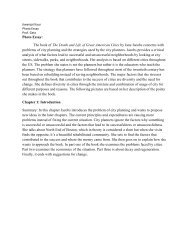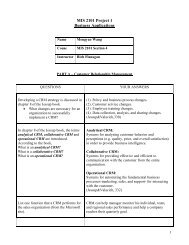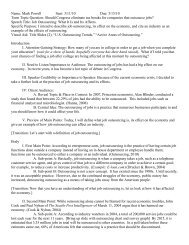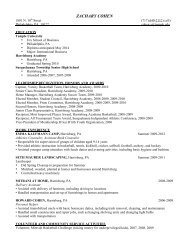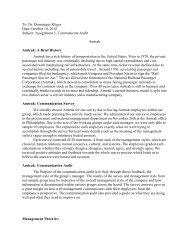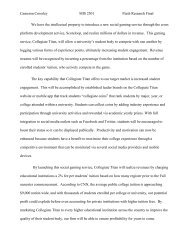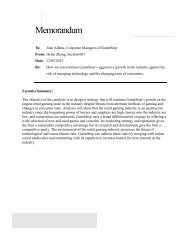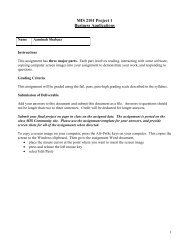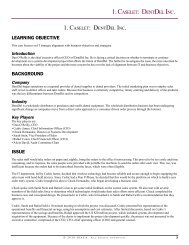Stakeholder analysis for R&D project management - Temple Fox MIS
Stakeholder analysis for R&D project management - Temple Fox MIS
Stakeholder analysis for R&D project management - Temple Fox MIS
You also want an ePaper? Increase the reach of your titles
YUMPU automatically turns print PDFs into web optimized ePapers that Google loves.
Arun A. Elias, Robert Y. Cavana and Laurie S. Jackson<br />
identified and analysed.He also uses a two dimensional<br />
grid as an analytical device to depict an<br />
organisation’s stakeholders.The first dimension categorises<br />
stakeholders by interest or stake and the second<br />
dimension is in terms of power.He makes the grid<br />
more realistic by improving on the classical stakeholder<br />
grid to prepare a real world stakeholder grid.<br />
At the process level, it is necessary to understand<br />
how the organisation either implicitly or explicitly<br />
manages its relationships with its stakeholders, and<br />
whether these processes fit with the rational stakeholder<br />
map of the organisation.According to Freeman,<br />
existing strategic processes that work reasonably<br />
well could be enriched with a concern <strong>for</strong> multiple<br />
stakeholders.For this purpose, he uses a revised<br />
version of Lorange’s (1980) schema <strong>for</strong> strategic<br />
<strong>management</strong> processes.<br />
The transactional level involves, understanding the<br />
set of transactions or bargains among the organisation<br />
and its stakeholders, and deducing whether these<br />
negotiations fit with the stakeholder map and the<br />
organisational processes <strong>for</strong> stakeholders.According<br />
to Freeman successful transactions with stakeholders<br />
are built on understanding the legitimacy of the<br />
stakeholder and having processes to routinely surface<br />
their concerns.<br />
Broadly, the emphasis of Freeman’s book is to<br />
construct an approach to <strong>management</strong> that takes the<br />
external environment into account in a systematic way.<br />
He provides a solid theoretical basis <strong>for</strong> the understanding<br />
of the stakeholder concept and paved the way<br />
<strong>for</strong> extensive future research in the field.<br />
3.3. Dynamics of stakeholders<br />
Another interesting characteristic of stakeholder concept<br />
is the dynamics of stakeholders.Over time, the<br />
mix of stakeholders may change.New stakeholders<br />
may join and wish to be included in any considerations,<br />
while others may drop out, through no longer<br />
being involved in the process.<br />
The concept of the dynamics of stakeholders was<br />
acknowledged by Freeman (1984), and according to<br />
him, in reality stakeholders change over time, and their<br />
stakes change depending on the strategic issue under<br />
consideration.Alkhafaji (1989) also contributed to<br />
the understanding of this concept.To explain the<br />
dynamics, he defined stakeholders as the ‘groups to<br />
whom the corporation is responsible’.<br />
Another notable work on this concept was by<br />
Mitchell et al.(1997).They proposed that classes of<br />
stakeholders can be identified by the possession or<br />
attributed possession of one or more of three relationship<br />
attributes: power, legitimacy and urgency.According<br />
to them, a party to a relationship has power, to<br />
the extent it has or can gain access to coercive,<br />
utilitarian or normative means, to impose its will in the<br />
relationship.For explaining legitimacy they used the<br />
definition of Suchman (1995).Suchman defined<br />
legitimacy as a generalised perception or assumption<br />
that the actions of an entity are desirable, proper or<br />
appropriate within some socially constructed system of<br />
norms, values, beliefs and definitions.They defined<br />
urgency as the degree to which stakeholder claims call<br />
<strong>for</strong> immediate attention.By including urgency as an<br />
attribute, a dynamic component was added to the<br />
process whereby stakeholders attain salience in the<br />
minds of managers.By combining these attributes they<br />
generated a typology of stakeholders.<br />
According to their typology (Figure 2), if a stakeholder<br />
possesses only one of the three attributes, they<br />
are termed latent stakeholders and have low stakeholder<br />
salience.If the only attribute present is power,<br />
such stakeholders are called dormant stakeholders; if<br />
it is only legitimacy, they are called discretionary<br />
stakeholders and if only urgency, they are called<br />
demanding stakeholders.<strong>Stakeholder</strong> salience will be<br />
moderate, if two attributes are present and such<br />
stakeholders are called expectant stakeholders.Among<br />
the expectant stakeholders, those having power and<br />
legitimacy only are called dominant stakeholders;<br />
those having legitimacy and urgency only are called<br />
dependent stakeholders and those having power and<br />
urgency only are called dangerous stakeholders.<br />
<strong>Stakeholder</strong> salience will be high where all the three<br />
attributes are perceived by managers to be present in a<br />
stakeholder and they are called definitive stakeholders.<br />
Further the dynamic qualities were illustrated by<br />
showing how stakeholders can shift from one class to<br />
another, when the salience of stakeholders increase=decrease<br />
by attaining=losing one or more of the<br />
attributes.Later, Agle et al.(1999) confirmed the<br />
model by empirically testing Mitchell et al.’s (1997)<br />
theoretical model.<br />
POWER<br />
URGENCY<br />
1<br />
Dormant<br />
<strong>Stakeholder</strong> 4<br />
Dominant<br />
<strong>Stakeholder</strong><br />
5<br />
Dangerous<br />
<strong>Stakeholder</strong><br />
3<br />
Demanding<br />
<strong>Stakeholder</strong><br />
7<br />
Definitive<br />
<strong>Stakeholder</strong><br />
6<br />
Dependant<br />
<strong>Stakeholder</strong><br />
Figure 2.<strong>Stakeholder</strong> typology.<br />
Source: Mitchell et al.1997, Figure 2, p.874.<br />
LEGITIMACY<br />
2<br />
Discretionary<br />
<strong>Stakeholder</strong><br />
8<br />
Nonstakeholder<br />
304 R&D Management 32, 4, 2002 # Blackwell Publishers Ltd 2002




